The marine bearings market is split by type, use, and place from 2025 to 2035. The market for marine bearings will grow steadily in the coming years. This rise will be driven by more sea activities, new offshore energy jobs, and better ship engines. As the world needs more container ships, cruise ships, and warships, the need for strong, rust-free, and quiet bearings will go up. This boost will grow the market from USD 6,224.5 Million in 2025 to about USD 10,139.1 Million by 2035, growing at 4.3% per year.
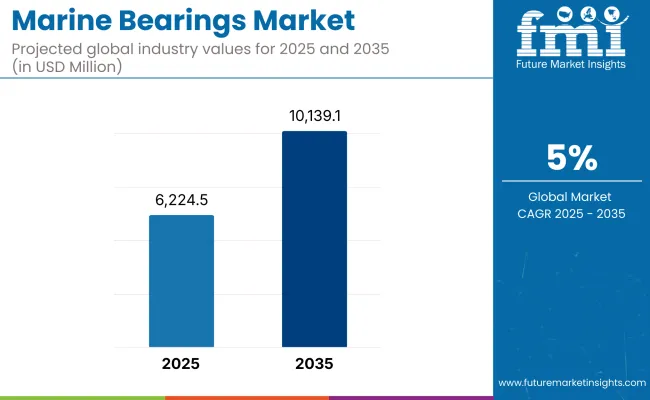
| Metric | Value |
|---|---|
| Market Size (2025E) | USD 6,224.5 Million |
| Market Value (2035F) | USD 10,139.1 Million |
| CAGR (2025 to 2035) | 5% |
Bearings are crucial in ships as they cut down on friction and wear. This means parts last longer and work better. The world is also moving toward greener ships and new emission rules. This shift makes shipbuilders and operators use advanced bearings that need less upkeep and fuel. Also, with more folks using hybrid and electric ship engines, bearing designs have to improve. This is driving innovation in materials and techniques.
Asia-Pacific will lead the marine bearings market in the next ten years. This is due to strong shipbuilding, growing ports, and more offshore energy projects. China, South Korea, and Japan make many ships. They use new sea tech like electric engines and fuel-saving motors, boosting the need for top-quality, easy-care bearings. Offshore wind farms and deep-sea projects, mainly in China and India, need tough, rust-proof bearings. Local support from governments helps boost local production and eco-friendly sea transport.
Europe has a big part of the market, led by its top role in clean and green shipping. Countries like Germany, the Netherlands, and Norway are leading the way to green ships. They put money into vessels run by LNG, mix engines, and electric drive systems. These need new bearing systems that work well and are good for the earth. The EU’s “Fit for 55” plan and green shipping rules are speeding up the use of next-gen bearings made from green materials with better no-lube performance.
North America sees steady market growth. This is due to fleet upgrades and more funds for offshore oil and gas work, especially in the Gulf of Mexico. The USA Navy and Coast Guard are refreshing old fleets, boosting the need for new, and long-lasting bearings. These new bearings have longer service times and can be monitored for wear. Canada is also focusing on Arctic sea work, which needs bearings that can handle the harsh cold and break through ice. Key companies in the area and more money in marine robots also help drive this growth.
Challenge
High Manufacturing and Lifecycle Costs
The marine bearings market struggles with high material costs and precise manufacturing needs. The sea is tough, with saltwater, heavy loads, and speed changes. Bearings must resist these factors. Makers use special materials like polymer, bronze, and ceramic, raising costs. Regular upkeep or swaps are common, especially for ships working hard, adding more costs and causing downtime. This hurts shipping schedules.
Opportunity
Advancements in Smart Bearings and Green Marine Technology
As the marine world goes more digital, new tools bring big chances for growth. Smart sensors and alert systems help keep track of bearing health, cutting down on sudden breakdowns. This means we can plan repairs better and save on upkeep costs, making parts last longer. There’s also a need for green bearings that don’t need much oil, preventing spills that harm sea life. With a global shift to cleaner energy and shipping, these new products are in high demand, especially for electric and hybrid systems. Makers who give strong, green, and smooth bearings can lead the next wave of market growth.
The marine bearings market saw a steady rise from 2020 to 2024. This was due to more global trade by sea, new shipbuilding tech, and more money put into finding oil offshore. The pandemic did slow things down at first, but the industry bounced back fast.This growth was because of demand for bearings that need little care, don't rust, and save fuel.
From 2025 to 2035, the market is set to grow a lot. This jump will come from strict green rules for fuel-efficient marine gear, more use of electric and hybrid engines, and more offshore oil and gas search projects. New tech will bring in self-lubricating, eco-friendly bearings made of polymers. These will be used in subs, navy ships, commercial boats, and yachts. Growth will be big in Asia-Pacific with large shipbuilding places like China, South Korea, and Japan. Government and private sector spending in defense and sea transport will keep the market growing over time.
Market Shifts: 2020 to 2024 vs. 2025 to 2035
| Key Dimensions | 2020 to 2024 |
|---|---|
| Dominant Regions | Asia-Pacific, Western Europe |
| Technology Focus | Traditional metal-based bearings |
| End-User Sectors | Commercial shipping, defense , fishing |
| Environmental Standards | Moderate compliance |
| Material Trends | Bronze, babbitt , white metal |
| Maintenance Requirements | High-maintenance, periodic lubrication |
| Investment in R&D | Limited to large OEMs |
| Application Shift | Propeller shafts, stern tubes, rudders |
| Supply Chain | Centralized production hubs |
| Key Dimensions | 2025 to 2035 |
|---|---|
| Dominant Regions | Asia-Pacific (China, South Korea), growing in MEA and Latin America |
| Technology Focus | Advanced polymer, composite, and self-lubricating bearings |
| End-User Sectors | Naval applications, offshore energy, luxury yachts, autonomous ships |
| Environmental Standards | Strict IMO and regional environmental mandates |
| Material Trends | Composite, ceramic-coated, and non-metallic materials |
| Maintenance Requirements | Low-maintenance, long-life bearings with built-in lubrication systems |
| Investment in R&D | Broad-based innovation from OEMs and startups |
| Application Shift | Electrified propulsion units, dynamic positioning systems |
| Supply Chain | Distributed manufacturing, regional customization |
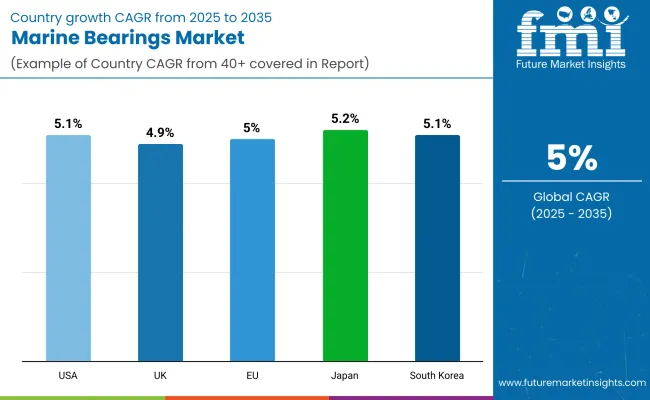
The marine bearings market in the United States is growing steadily. It's due to more cash in naval defense, modern fleets, and bigger offshore energy projects. The USA Coast Guard (USCG) and American Bureau of Shipping (ABS) set the rules for marine tools and parts.
Main trends are more use of eco-friendly and water-lubricated bearings, higher use of composite and polymer materials to resist rust, and more upgrades for older naval and cargo ships.
| Country | CAGR (2025 to 2035) |
|---|---|
| USA | 5.1% |
In the UK, big marine trade, money put into making ships, and a push for green ways to sail support the marine bearings market. The Maritime and Coastguard Agency (MCA) and Lloyd's Register keep marine safety and class in check.
Some key trends are more need for non-metal bearings in clean spots, new bearing stuff for ice ships, and use in hybrid and electric ship engines.
| Country | CAGR (2025 to 2035) |
|---|---|
| UK | 4.9% |
The marine bearings market in the European Union is getting bigger. This is because of strict rules about the environment, the need for green ship parts, and a lot of activity in the North and Baltic Seas. The European Maritime Safety Agency (EMSA) and groups like DNV make sure the rules are followed.
Germany, the Netherlands, and France are helping the market grow. They have good shipbuilding places and are updating old ships. Some key trends are new water-based and low-friction bearings. There is also a push to cut down on noise under water.
| Region | CAGR (2025 to 2035) |
|---|---|
| European Union (EU) | 5.0% |
Japan's marine bearings market is doing well because of its strong shipbuilding industry, big commercial fleet, and strict ocean rules. The Ministry of Land, Infrastructure, Transport and Tourism (MLIT) and ClassNK (Nippon KaijiKyokai) keep watch.
Key trends include more use of plastic bearings in ships that save fuel, research in strong bearing systems for tankers and container ships, and smart monitoring systems for better upkeep.
| Country | CAGR (2025 to 2035) |
|---|---|
| Japan | 5.2% |
South Korea sees a rise in the marine bearings market. The country leads in making ships and marine tech. The Korea Register of Shipping and the Ministry of Oceans and Fisheries check standards and ship safety.
Trends show more use of seawater-lubricated bearings for green ships, new tech in stern tube and rudder bearings, and adding systems to watch conditions for longer service life.
| Country | CAGR (2025 to 2035) |
|---|---|
| South Korea | 5.1% |
Ball Bearings Gain Momentum for Compact Load Handling Needs while Industrial Machinery Applications Anchor Market Demand
The marine bearings market is moving forward at a steady pace. This is due to the rise in sea industrial growth, upgrades to ships, and a bigger push for better performance. The market is split by type and use. There's a growing trend towards ball bearings because of their small size and ability to handle lighter tasks well. At the same time, industrial machinery is still the top use area since shipbuilders look for strong and reliable parts to handle heavy tasks on ships.
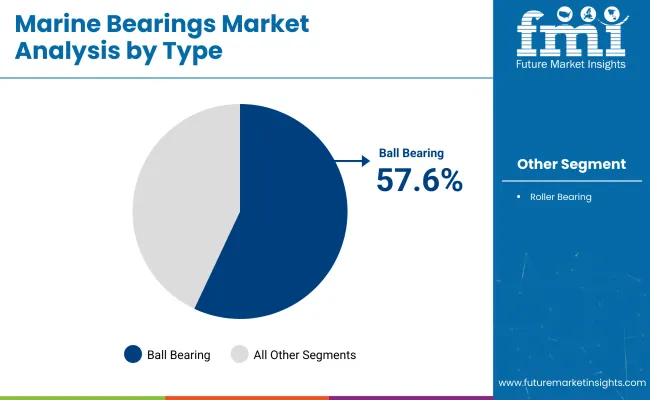
| Type | Market Share (2025) |
|---|---|
| Ball Bearing | 57.6% |
Ball Bearings Take the Lead with Precision and Compact Efficiency
Ball bearings are the most common type of bearing. They are liked because they can handle both side and end loads in tight spots. With less friction and smoother movement, they work great in marine systems like pumps, motors, and navigation tools. As ships aim to save energy and use smaller parts, ball bearings stay the top choice due to their versatility and better cost over time.
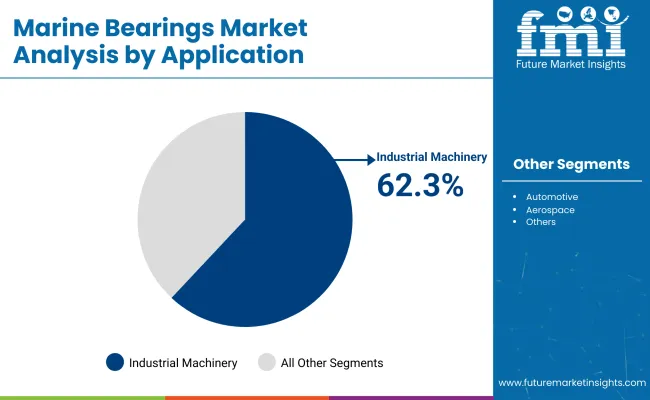 Application Market Share (2025) Industrial Machinery 62.3%
Application Market Share (2025) Industrial Machinery 62.3%
Industrial Machinery Drives Market Demand with High Operational Reliability
Big machines in shipping use marine bearings the most. They are needed to give strong support to engines, winches, and cargo systems. These bearings must handle heavy loads, shakes, and harsh sea conditions. As more money is put into sea infrastructure and new tech, the need for top-notch, durable bearings in machines keeps rising all over the world.
The marine bearings market is expected to grow steadily over the coming years due to positive seaborne trade activity, an upswing in shipbuilding activities and greater emphasis on energy efficiency and environmental sustainability.
Marine bearings are essential in a vessel or machine to operate in the most effective and efficient way, whether they are on propulsion, steering, or auxiliary equipment.However, the monitoring of marine bearings is a tricky job as well. Market size and share of major players, along with the trends in the automotive aftermarket will enable existing and new entrants take informed business decisions.
Market Share Analysis by Company
| Company Name | Estimated Market Share (%) |
|---|---|
| SKF | 18-22% |
| Wärtsilä | 15-19% |
| Thordon Bearings Inc. | 12-16% |
| Trelleborg AB | 10-14% |
| Schaeffler Group | 8-12% |
| Other Companies (combined) | 25-35% |
| Company Name | Key Offerings/Activities |
|---|---|
| SKF | In 2024, new eco-friendly ship bearings were introduced. They help lower friction and save fuel. The next year, the company grew its service network in Asia-Pacific to aid the expanding shipping market. |
| Wärtsilä | In 2024, a new propulsion system with advanced bearings was launched. It improves ship performance and cuts emissions. By 2025, the firm joined forces with top shipbuilders to use these systems in new ships. |
| Thordon Bearings Inc. | In 2024, water-lubricated bearings were created. These need no oil, which is better for the earth. The next year, the company signed deals with navies to supply these green bearings for military ships. |
| Trelleborg AB | In 2024, the company added composite bearings to its products. These last long in marine settings. By 2025, a new plant opened in Europe to keep up with rising orders. |
| Schaeffler Group | In 2024, smart bearing solutions with real-time monitoring were revealed. By 2025, the company teamed up with shipping firms to fit these bearings on their ships for better upkeep. |
Key Company Insights
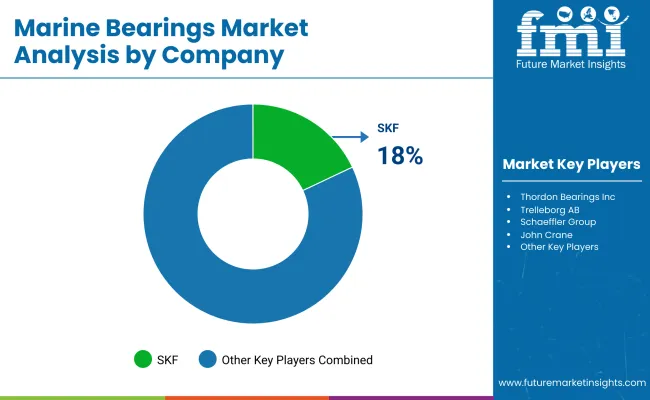
SKF (18-22%)
SKF uses its many years in bearing making to give new and green solutions. It aims to increase ship efficiency and cut down bad effects on the earth.
Wärtsilä (15-19%)
Wärtsilä emphasizes integrated marine solutions, combining advanced bearing technologies with propulsion systems to deliver comprehensive performance enhancements for vessels.
Thordon Bearings Inc. (12-16%)
Thordon focuses on water-based bearing systems. They care about the earth by getting rid of the need for oil-based lubricants in ships.
Trelleborg AB (10-14%)
Trelleborg focuses on developing composite and polymer bearings that offer superior durability and wear resistance, catering to the demanding conditions of marine environments.
Schaeffler Group (8-12%)
Schaeffler adds digital tech to its bearings. This makes smart products that let users watch and fix marine machines before they break.
Other Key Players (Combined)
Several other companies contribute to the competitive landscape of the Marine Bearings Market, including:
The market size was approximately USD 6,224.5 Million in 2025.
The market is projected to reach approximately USD 10,139.1 Million by 2035.
Key drivers include the increasing demand for commercial vessels, expansion of the offshore wind energy sector, and the adoption of eco-friendly bearings to enhance fuel efficiency and reduce maintenance costs.
China, United States, India, Japan, and Germany are key contributors to the market.
The offshore wind energy segment is expected to lead due to the growing investments in renewable energy projects and the need for durable bearings in harsh marine environments.






Full Research Suite comprises of:
Market outlook & trends analysis
Interviews & case studies
Strategic recommendations
Vendor profiles & capabilities analysis
5-year forecasts
8 regions and 60+ country-level data splits
Market segment data splits
12 months of continuous data updates
DELIVERED AS:
PDF EXCEL ONLINE
Marine-grade Polyurethane Market Size and Share Forecast Outlook 2025 to 2035
Marine Electronics Market Size and Share Forecast Outlook 2025 to 2035
Marine Toxin Market Size and Share Forecast and Outlook 2025 to 2035
Marine Thermal Fluid Heaters Market Size and Share Forecast Outlook 2025 to 2035
Marine Nutraceutical Market Size and Share Forecast Outlook 2025 to 2035
Marine Power Battery System Market Size and Share Forecast Outlook 2025 to 2035
Marine Life Raft Market Size and Share Forecast Outlook 2025 to 2035
Marine Trenchers Market Size and Share Forecast Outlook 2025 to 2035
Marine Electronics Tester Market Size and Share Forecast Outlook 2025 to 2035
Marine Steering Systems Market Size and Share Forecast Outlook 2025 to 2035
Marine & Dock Gangways Market Size and Share Forecast Outlook 2025 to 2035
Marine HVAC System Market Size and Share Forecast Outlook 2025 to 2035
Marine Outboard Engines Market Size and Share Forecast Outlook 2025 to 2035
Marine Stabilizers Market Size and Share Forecast Outlook 2025 to 2035
Marine Fuel Injection System Market Size and Share Forecast Outlook 2025 to 2035
Marine Energy Market Size and Share Forecast Outlook 2025 to 2035
Marine Propulsion Engine Market Size and Share Forecast Outlook 2025 to 2035
Marine Protein Hydrolysate Market Size and Share Forecast Outlook 2025 to 2035
Marine Fin Stabilizer Market Size and Share Forecast Outlook 2025 to 2035
Marine Extract Market Size and Share Forecast Outlook 2025 to 2035

Thank you!
You will receive an email from our Business Development Manager. Please be sure to check your SPAM/JUNK folder too.
Chat With
MaRIA